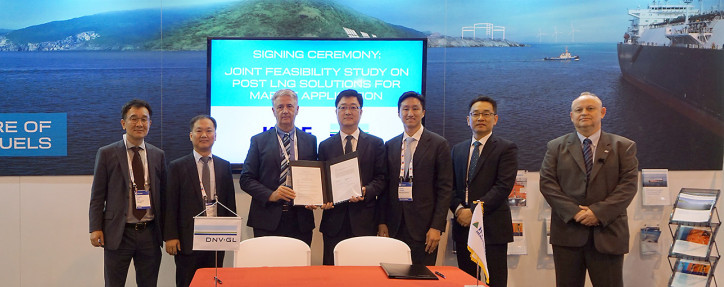DNV GL and Korea Shipbuilding & Offshore Engineering (KSOE*) signed a memorandum of understanding (MOU) to cooperate on the development of low and zero-carbon ship technology. Ki-Sun Chung, Senior Executive Vice President and Won-Ho Joo, Director of Advanced Research Center from KSOE with Conn Fagan, Vice President and Sung-Ho Shin from DNV GL, attended the signing ceremony at the Gastech trade fair in Houston.

The MOU is a response to the growing market, public, and regulatory pressure on the shipping industry, to reduce greenhouse gas (GHG) emissions.
“We expect DNV GL's accumulated data on future ship fuel will be combined with HHI ‘s advanced gas engineering technology and will come up with the innovative technology standards,” said Won-Ho Joo, KSOE, Director of Advanced Research Center at the signing ceremony.
The purpose of the MOU is to develop cutting edge solutions for zero-emission ship technologies. The project will include further study on LNG as a ship fuel, as this is currently the leading low-emission/lower-carbon fuel, and an assessment on its potential as a transitional step to zero-carbon options. KSOE and DNV GL will work together to conduct comprehensive research on assessing future ship fuels such as LNG, hydrogen, ammonia and biofuels, verifying both the fuel supply and propulsion systems to use those fuels, and assessing bunkering convenience and safety.
"Alongside improvements to energy efficiency, new low and zero-carbon fuels will play an essential role in the maritime industry of the future,” said Conn Fagan, DNV GL – Maritime, Vice President. “The ongoing energy transition is starting to reshape the shipping industry and this collaboration is an opportunity to provide competitive and practical solutions to the entire industry."
DNV GL's recent report, "Maritime Forecast 2050", identified fuel flexibility and technologies to bridge changing fuel usage as essential strategies for the shipping industry to adapt to the energy transition and prepare for a low carbon future. In the deep-sea segment especially, dual-fuel solutions and alternative fuel “ready” solutions could smooth the transition by laying the groundwork for future retrofits. Combined with bridging technologies such as adaptable storage tanks, onboard systems and shore-side fuel infrastructure, this could give the industry more options as new fuels and technologies emerge.
The report predicts that by 2050, carbon-neutral fuels will supply 30 to 40 percent of the global fleet’s total energy, with liquefied methane gas (from fossil and non-fossil sources) accounting for 40-80 percent of the energy mix. The Maritime Forecast also suggests that that ammonia, bio-diesel, liquid bio-gas and electric fuel are a promising carbon neutral options for deep-sea operation.
*KSOE is the sub-holding company of the HHI group’s shipbuilding and offshore business.
Source: DNV GL